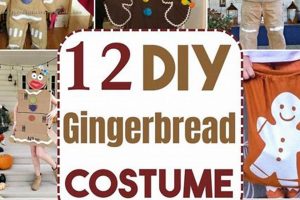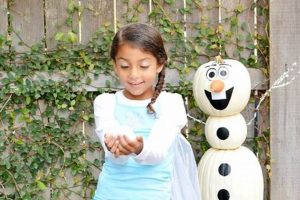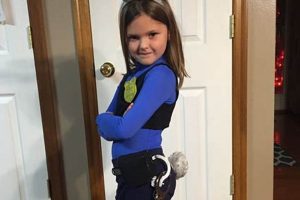Creating a Minerva McGonagall outfit involves assembling various garments and accessories to replicate the appearance of the character from the Harry Potter series. This typically includes a long, dark green or black robe, a pointed hat, and potentially a tartan shawl or scarf. The pursuit often entails finding affordable alternatives and utilizing crafting skills to emulate the professor’s distinctive look.
The significance of constructing such an ensemble lies in the ability to personalize and customize it to individual preferences and budgets. It encourages creativity, resourcefulness, and a deeper engagement with the source material. Historically, replicating character costumes has been a popular form of fan expression, allowing individuals to connect with fictional worlds in a tangible way. The act of creating the attire provides a sense of ownership and accomplishment beyond simply purchasing a pre-made version.
The subsequent discussion will explore key elements for achieving a convincing representation, detailing the essential components, providing guidance on material selection, and offering tips for achieving the desired aesthetic through simple modification techniques. Furthermore, it will offer budget-friendly options and alternative approaches for those seeking an accessible and satisfying result.
Constructing a McGonagall-Inspired Ensemble
Achieving a convincing representation of Professor McGonagall through a self-made costume requires careful attention to detail and a strategic approach to resource utilization. The following tips provide guidance on key aspects of the creation process.
Tip 1: Robe Selection and Adaptation: Begin with a long, dark-colored robe. If a commercially available robe lacks the desired detailing, consider adding velvet panels to the collar or sleeves for a more academic aesthetic.
Tip 2: Hat Modification: A standard pointed witch or wizard hat can be transformed. Stiffen the brim with interfacing or wire to achieve a more structured shape. Consider adding a subtle trim, such as a simple ribbon or cord, for added detail.
Tip 3: Tartan Integration: A tartan shawl or scarf is crucial. Authentic Scottish tartans can be costly; consider a less expensive fabric with a similar pattern or a carefully chosen plaid. Drape the tartan strategically over the shoulders or pin it to the robe for a realistic effect.
Tip 4: Eyewear Acquisition: Professor McGonagall’s spectacles are a key identifier. Choose a pair of round or slightly oval frames, preferably in a metal finish. Non-prescription glasses are readily available and offer an affordable option.
Tip 5: Hairstyle Replication: The character’s tightly wound bun is essential. Consider a wig if natural hair length or texture presents a challenge. Secure the hair tightly and neatly for an accurate representation.
Tip 6: Accessory Considerations: A simple wand, crafted from wood or purchased as a replica, completes the look. Subtle additions, such as a brooch or a plain handbag, can enhance the overall impression.
The judicious application of these tips will result in a recognizable and respectful homage to the character. Careful planning and attention to detail are paramount to success.
The concluding section will offer insights on cost-effective alternatives and strategies for maximizing the impact of the finished garment.
1. Robe Fabrication
Robe fabrication constitutes a fundamental aspect of creating a convincing Minerva McGonagall outfit. The robe serves as the primary garment and its construction directly influences the overall aesthetic and accuracy of the representation. A well-executed robe establishes the foundation upon which other costume elements build.
- Material Selection
The choice of fabric significantly impacts the appearance and drape of the robe. Dark-colored wool, heavy cotton, or blends offer a suitable weight and texture. Lighter materials may require lining to achieve the desired structure and prevent transparency. The selected material should be durable and capable of holding its shape throughout wear.
- Pattern Design and Construction
Utilizing a pre-existing robe pattern or drafting one from scratch requires careful consideration of accurate proportions and silhouette. The robe should be long, flowing, and feature wide sleeves. Precise stitching and seam finishing are crucial for a professional appearance and to prevent fraying or tearing. Accurate construction ensures the robe hangs correctly and conforms to the character’s iconic look.
- Collar and Sleeve Detailing
The robe’s collar and sleeves often feature specific details, such as velvet panels or contrasting fabric trims. These elements add visual interest and enhance the academic aesthetic. Accurately replicating these details requires careful measuring, cutting, and attaching the supplementary fabrics. The precision of these additions contributes significantly to the overall authenticity of the outfit.
- Alteration and Customization
A commercially purchased robe may require alterations to better match the character’s specific attire. Adjusting the length, adding decorative elements, or modifying the sleeves can refine the appearance. Customization allows for personalization and ensures the robe complements the individual’s body shape and proportions, resulting in a more polished and convincing portrayal.
The success of a self-made Minerva McGonagall ensemble relies heavily on the quality and accuracy of the robe. By prioritizing appropriate material selection, precise pattern design, meticulous construction, and thoughtful customization, individuals can create a garment that effectively embodies the character’s distinctive style, enhancing the overall impact of the diy mcgonagall costume.
2. Hat Customization
The success of a Minerva McGonagall-inspired costume hinges significantly on accurate hat customization. The hat, a prominent element of the character’s silhouette, functions as a visual keystone. A standard, unmodified pointed hat will often appear generic, failing to capture the specific character’s distinct silhouette. Therefore, intentional alterations are vital to distinguish the creation from a typical witch or wizard costume. For example, stiffening the brim to achieve a more structured and slightly angled shape, as opposed to a floppy, unstructured form, immediately elevates the sense of accuracy. Furthermore, adding trim, such as a specific type of cord or ribbon, to the base of the hat echoes screen-accurate detail, bolstering the costume’s overall faithfulness.
Practical application of this understanding extends to material choices and construction techniques. Substituting felt with buckram or incorporating wire into the brim’s edge allows
for shaping and maintaining a desired angle. The addition of a lining, even if unseen, provides structural integrity and contributes to a professional finish. Moreover, research into historical hatmaking methods can inform the customization process, leading to more authentic-looking results. Consider the visual impact a crumpled, misshapen hat presents versus a hat with crisp lines and deliberate detailing. The latter provides a more convincing portrayal and avoids detracting from other elements of the costume.
In conclusion, hat customization represents a critical aspect of achieving a convincing diy mcgonagall costume. Ignoring this element compromises the entire ensemble. By prioritizing accuracy in shape, materials, and detailing, the hat transforms from a simple accessory into a powerful visual identifier, contributing substantially to the overall effectiveness of the character portrayal. Challenges in sourcing materials or mastering techniques can be overcome through diligent research and practice, ultimately yielding a more satisfying and recognizable result. The transformation highlights the practical impact of attentive detail in diy projects.
3. Tartan Integration
Tartan integration forms a crucial aspect of replicating Professor McGonagall’s attire within the realm of self-assembled costumes. The specific tartan pattern contributes significantly to the character’s visual identity and is not merely a decorative element. Its selection and application require careful consideration to ensure accuracy and overall effectiveness.
- Historical Accuracy
The specific tartan associated with Professor McGonagall’s character in the Harry Potter films is reportedly the Clan Fraser tartan. Adhering to this historical detail significantly enhances the costume’s authenticity. Utilizing inaccurate or generic tartan patterns detracts from the overall impression and diminishes the portrayal’s credibility. Researching the correct tartan is therefore paramount.
- Material Sourcing and Budgetary Constraints
Authentic Clan Fraser tartan fabric can be costly and difficult to acquire. Practical considerations often necessitate the use of alternative materials or less expensive substitutes. Options include searching for similar patterns in readily available fabrics such as wool blends or even printed cotton. Balancing the desire for accuracy with the realities of budget is a critical aspect of the decision-making process.
- Application Techniques
The manner in which the tartan is incorporated into the costume also influences its success. The tartan can be implemented as a shawl, a scarf, or even as trim on the robe itself. The size, shape, and draping of the tartan element all contribute to the overall visual impact. Studying screen captures and official promotional materials offers valuable insights into the character’s styling.
- Contextual Consistency
Beyond the visual representation, the choice of tartan can evoke deeper connections to the character’s Scottish heritage. This subtle detail can enrich the overall portrayal and demonstrate a thorough understanding of the source material. While not always explicitly stated, the underlying implication of cultural accuracy adds an additional layer of depth to the DIY approach.
Successfully integrating tartan into a self-constructed McGonagall costume requires a balance of research, resourcefulness, and attention to detail. While budgetary constraints may necessitate compromises, a clear understanding of the tartan’s significance and its proper application remains essential for achieving a credible and satisfying result.
4. Eyeglass Selection
Eyeglass selection represents a pivotal aspect in the creation of a convincing Minerva McGonagall costume. The character’s distinctive spectacles are instantly recognizable and contribute significantly to her overall image. The accuracy and appropriateness of the chosen eyewear can substantially impact the success of the ensemble.
- Frame Shape and Style
Professor McGonagall’s eyeglasses typically feature round or slightly oval frames. The specific shape and style should align with the character’s portrayal in the Harry Potter films. Frames that are too modern or stylized will detract from the costume’s authenticity. For example, geometric or overly large frames would be inappropriate. Opting for a classic, understated design is essential.
- Material and Finish
Metal frames, often in gold, silver, or a dark metallic finish, are the most suitable choice. Plastic frames, particularly those with bold colors or textures, should be avoided. The material and finish contribute to the overall impression of sophistication and academic rigor associated with the character. A matte or slightly aged finish can further enhance the realism.
- Lens Considerations
The lenses should ideally be clear or slightly tinted. Darkly tinted lenses or sunglasses are inappropriate and misrepresent the character. Non-prescription lenses are a practical option for individuals who do not require corrective vision. The lenses should be clean and free from scratches or imperfections to ensure a clear and unobstructed appearance.
- Proportionality and Fit
The size and fit of the eyeglasses should be proportional to the wearer’s face. Frames that are too large or too small will appear disproportionate and detract from the overall effect. The eyeglasses should sit comfortably on the nose and ears without slipping or causing discomfort. Proper fit contributes to both the aesthetic and practical aspects of the costume.
The meticulous selection of eyeglasses, adhering to the character’s established visual characteristics, elevates a self-made Minerva McGonagall costume from a generic imitation to a recognizable and respectful tribute. The eyewear serves as a key identifier, enhancing the overall authenticity and impact of the ensemble. Disregarding this detail undermines the effectiveness of other costume elements, highlighting the importance of comprehensive attention to detail in crafting a convincing representation.
5. Hair Arrangement
Hair arrangement serves as a critical, and often overlooked, component in achieving a successful Minerva McGonagall representation. The character’s signature tightly wound bun is immediately recognizable, and failure to accurately replicate this hairstyle significantly diminishes the overall effectiveness of the costume. A haphazard or dissimilar hairstyle, regardless of the accuracy of other elements, will instantly disrupt the illusion and detract from the intended portrayal. The hairstyle functions as a visual anchor, connecting the costume to the specific character rather than simply a generic witch or wizard persona. Consider the visual impact: a carefully styled bun conveys authority and meticulousness, aligning with the character’s established traits, while a loose or modern hairstyle contradicts these associations.
Practical application necessitates careful planning and execution. Individuals with sufficient natura
l hair length and texture can adapt their own hair through precise styling techniques, utilizing tutorials and reference images to achieve the desired shape and tightness. Alternatives include employing wigs, hairpieces, or extensions to more easily replicate the bun. These options offer greater flexibility and control over the final appearance, particularly for individuals with shorter hair or differing hair types. Achieving a secure and stable bun is paramount; any looseness or slippage throughout wear can compromise the overall effect and require constant adjustment. Furthermore, the color and texture of the hair, whether natural or artificial, should closely resemble the character’s depiction to maintain visual consistency. A wig with an unnatural shine or an incorrect color will negatively impact the authenticity of the representation.
In summary, accurate hair arrangement constitutes an integral element of a convincing diy McGonagall costume. While seemingly a minor detail, its influence on the overall impression is substantial. Overcoming challenges in styling or acquiring appropriate hairpieces through careful planning and execution yields a more credible and satisfying result. The visual impact underscores the practical significance of attention to detail, transforming a standard costume into a recognizable and respectful representation of the character. Neglecting this aspect undermines the entire endeavor, reinforcing the need for a holistic approach to costume construction.
Frequently Asked Questions
This section addresses common inquiries and misconceptions surrounding the creation of a self-made Minerva McGonagall costume. The following questions provide clarifying information for individuals undertaking this project.
Question 1: Is it necessary to replicate the precise Clan Fraser tartan for an accurate representation?
While utilizing the authentic Clan Fraser tartan enhances accuracy, it is not strictly essential. Given budgetary constraints and sourcing difficulties, a similar tartan pattern or a carefully chosen plaid can serve as a viable alternative, provided it maintains the overall color scheme and visual impression.
Question 2: What is the most cost-effective approach to constructing the robe?
A cost-effective approach involves repurposing an existing long, dark-colored robe or purchasing inexpensive fabric to sew a simple robe. Utilizing readily available patterns and minimizing elaborate detailing can significantly reduce expenses. Prioritize essential features over complex embellishments.
Question 3: Are commercially available witch or wizard hats suitable, or do they require significant modification?
Commercially available witch or wizard hats often require modification to achieve the desired shape and silhouette. Stiffening the brim and adding subtle trim are essential alterations. The extent of modification depends on the quality and accuracy of the initial hat.
Question 4: What type of eyeglasses best represent Professor McGonagall’s eyewear?
Round or slightly oval metal frames, preferably in gold, silver, or a dark metallic finish, accurately represent Professor McGonagall’s eyewear. Avoid plastic frames, bold colors, or overly stylized designs. Non-prescription lenses offer a practical and affordable solution.
Question 5: Is professional hairstyling necessary to achieve the correct hairstyle?
Professional hairstyling is not required. With practice and the aid of tutorials, individuals can replicate the character’s tightly wound bun. Wigs, hairpieces, or extensions provide alternative solutions for those with shorter hair or differing hair types.
Question 6: How can the overall costume be enhanced without significantly increasing the cost?
Subtle additions, such as a simple wand crafted from wood, a brooch, or a plain handbag, can enhance the overall impression without substantial expense. Attention to detail in grooming and posture also contributes to the final result. The key lies in maximizing the impact of existing elements through careful styling and presentation.
In conclusion, achieving a convincing Minerva McGonagall costume through self-assembly requires a balance of research, resourcefulness, and attention to detail. While budgetary limitations may necessitate compromises, prioritizing key elements and carefully executing essential modifications will yield a satisfying result.
The subsequent discussion will explore advanced techniques and alternative approaches for individuals seeking to elevate their DIY McGonagall costume to a higher level of accuracy and detail.
Conclusion
This exploration has underscored that a successful “diy mcgonagall costume” necessitates a comprehensive approach encompassing robe construction, hat customization, tartan integration, eyeglass selection, and hair arrangement. Each element contributes significantly to the overall impression, and meticulous attention to detail is paramount in achieving a recognizable and respectful representation of the character. While budgetary constraints and resource limitations may influence specific choices, adherence to core design principles and a commitment to accuracy remain essential.
The pursuit of a convincing portrayal through self-assembly demands resourcefulness and dedication. The process transcends mere imitation, becoming an exercise in creative problem-solving and a testament to the enduring appeal of iconic characters. Continued refinement of techniques and a commitment to historical accuracy will ensure the enduring viability of this form of fan expression, perpetuating the legacy of Minerva McGonagall through carefully crafted homages.







